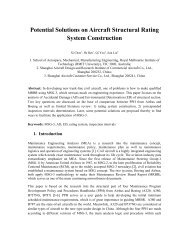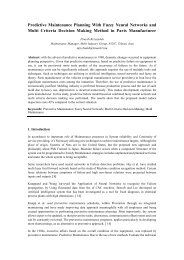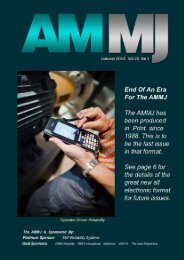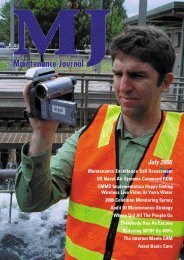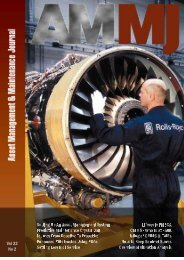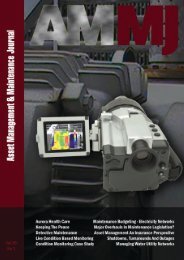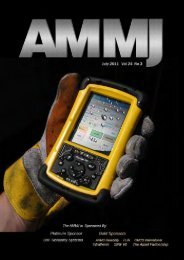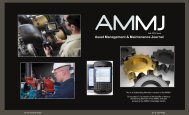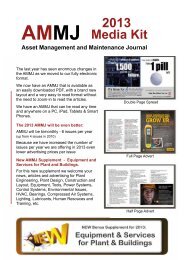DAY 1 - AMMJ
DAY 1 - AMMJ
DAY 1 - AMMJ
- No tags were found...
Create successful ePaper yourself
Turn your PDF publications into a flip-book with our unique Google optimized e-Paper software.
18Performance Benchmarking Updatelevels of management. The primary function of these managers is to enforce standards and, aswas stated earlier, to actively sponsor all cost-justified reliability improvement targets. The steeringcommittee is asking technician-workers to discuss methods and accomplishments, thus givingvisibility to the grassroots efforts.Fourteen Common Attributes ExaminedBest-of-Class companies share a large number of sound work practices, reliability engineeringimplementation concepts, and organizational alignments. Some of these have been highlightedearlier, whereas others are implicit and follow a logical pattern of progression. While their numberscould be easily expanded by simply going into greater detail, we are limiting our listing and examinationto 14 of these shared attributes:1. They have on their bidders’ lists only top-notch vendors and manufacturers. Theyrecognize that reliability comes at a price, and that competent suppliers are entitled to areasonable profit.2. They specify and procure equipment and components on the basis of lifecycle coststudies, having built reliability and low maintenance into the equipment specification.3. They engage in pre-award (pre-procurement) reviews, design audits, and selective,systematic, pre-delivery engineering quality control. First quartile companies know thatthis effort, while requiring an up-front investment, will always result in payback.4. They pay attention to detail, work towards perfection, and understand that “businessas usual” and “hurry up, we want it running again this afternoon” attitudes are intolerableimpediments to the achievement of reliability improvement in any plant.5. They are obsessed with doing every job right the first time. To that end, they develop,acquire, use, and consistently invoke written checklists and procedures across all jobfunctions.6. They treat every maintenance event as an opportunity to upgrade, with a view towardsrun-length extension. The decision on how to proceed is again based on lifecycle costconsiderations.7. They use major elements of predictive maintenance to determine when and how toperform preventive maintenance. They are aware that optimized, bottom-line cost-justifiedmaintenance is a composite of both PM and PdM.8. They will not tolerate the employment of highly trained machinery condition analysts(vibration monitoring technicians) to periodically acquire data from one thousand equipmentbearings, only to find out that 970 of these bearings show no signs of distress. Instead,they train their operators to perform equipment surveillance. Operators report deviationsfrom normal equipment behavior to the condition analyst for follow-up and definition ofremedial action, component upgrading, etc.9. Cross-functional teams perform true root cause failure analysis and monitor their overallprogress by maintaining accurate failure statistics. Top performers have a reasonably goodidea as to what improvements are feasible and, in fact, achieved elsewhere. Their repeatfailure events show significant downward trends.10. They recognize the virtual impossibility of acquiring expertise in all fields of majorequipment component design, application engineering and component optimization. Thisrealization prompts Best-of-Class companies to teach and actively pursue resourcefulnessby maximizing all aspects of vendor / manufacturer experience. Vendor and manufacturerstatistics are extensively consulted and design reviews performed whenever applicable andcost-justified. Electronic or conventional reference libraries are maintained and consultedby reliability professionals.<strong>AMMJ</strong> 20th ANNIVERSARY YEAR



